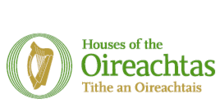- Oireachtas
-
This article is about the modern legislature. For alternative meanings, see Oireachtas (disambiguation).
Oireachtas
National Parliament
Type Type Bicameral Houses Dáil Éireann (31st)
Seanad Éireann (24th)Leadership Ceann Comhairle Seán Barrett, (FG)
since 9 March 2011Cathaoirleach Paddy Burke, (FG)
since 25 May 2011Structure Members 226
166 TDs
60 Senators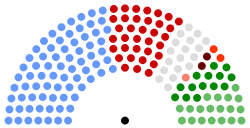
Dáil Éireann
Political groups- Fine Gael (74)
- Labour Party (37)
- Fianna Fáil (19)
- Sinn Féin (14)
- Socialist Party (2)
- People Before Profit (2)
- WUAG (1)
- Independents (16)
Chairman
- Ceann Comhairle (1)
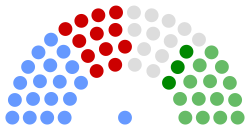
Seanad Éireann
Political groupsFine Gael (19)
Fianna Fáil (14)
Labour Party (12)
Sinn Féin (3)
Independents (12)Elections Dáil Éireann
Last election25 February 2011 Seanad Éireann
Last election26 April 2011 Meeting place 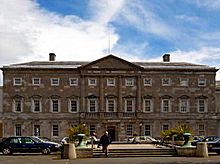
Leinster House, Dublin Website www.oireachtas.ie Ireland 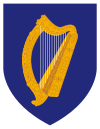
This article is part of the series:
Politics and government of
the Republic of IrelandConstitutionOireachtasJudiciaryDivisionsForeign policy
The Oireachtas (Irish pronunciation: [ɛrʲaxt̪ˠasˠ]), sometimes referred to as Oireachtas Éireann, is the "national parliament"[1] or legislature of Ireland. The Oireachtas consists of:
- The President of Ireland
- The two Houses of the Oireachtas (Irish: Tithe an Oireachtais):
The Houses of the Oireachtas sit in Leinster House in Dublin, an eighteenth-century ducal palace. The directly elected Dáil is by far the most powerful branch of the Oireachtas.
Contents
Composition
Dáil Éireann, the lower house, is directly elected under universal suffrage of all Irish and United Kingdom citizens who are resident and at least eighteen years of age. An election is held at least once in every five years as required by law. However the house can usually be dissolved at any time at the request of the Taoiseach (head of government). Dáil elections occur under the system of proportional representation by means of the single transferable vote. The Dáil has had 166 members since 1981.[2] The Seanad is not directly elected but consists of a mixture of members selected in a number of ways. 43 senators are elected by councillors and parliamentarians, 11 are appointed by the Taoiseach, and six are elected by two university constituencies, giving a total of 60 members. The President of Ireland is directly elected once in every seven years, for a maximum of two terms. However if, as has occurred on a number of occasions, a consensus among the larger political parties can result in only a single candidate being nominated, then no actual ballot occurs.
Role
To become law a bill must first be approved by both the Dáil and in most circumstances the Seanad (although the Dáil can override a Seanad refusal to pass a Bill), and then signed into law by the President. Bills to amend the Constitution must also be approved by the People in a referendum prior to being presented to the President. In most circumstances, the President is in effect obliged to sign all laws approved by the Houses of the Oireachtas, although he or she has the power to refer most bills to the Supreme Court for a ruling on constitutionality. The powers of the Seanad are in effect limited to delay rather than veto. It is the Dáil, therefore, that is the supreme tier of the Irish legislature. The general enacting formula for Acts of the Oireachtas is: "Be it enacted by the Oireachtas as follows:-", for an act with a preamble this enacting formula is, instead, "Be it therefore enacted by the Oireachtas as follows:—".
Powers
The Oireachtas has exclusive power to:
- Legislate, including a power vested in the Dáil of approving the financial resolutions relevant to the budget.
- Create subordinate legislatures.
- Propose changes to the constitution (must be initiated in the Dáil), which must then be submitted to a referendum.
- Raise military or armed forces.
- Allow international agreements to become part of the domestic law of the state.
- Pass certain laws having extraterritorial effect (in accordance with the similar practices of other states).
- Enact, when it considers a state of emergency to exist, almost any law it deems necessary.
Limitations
- Laws are invalid if, and to the extent that, they contradict the constitution.
- In the event of a conflict, EU law also takes precedence over acts of the Oireachtas, as is common throughout the European Union.
- It may not retrospectively criminalise acts that were not illegal at the time they were committed.
- It may not enact any law providing for the imposition of the death penalty, even during a state of emergency.
- It can only legislate for the Republic of Ireland and not for Northern Ireland.
Committees
The Oireachtas has a number of joint committees that include members of both houses. There are currently thirteen of these (the first ten below are based on the ten select committees of the Dáil):
- Joint Committee on Communications, Natural Resources and Agriculture
- Joint Committee on Environment, Transport, Culture and the Gaeltacht
- Joint Committee on European Union Affairs
- Joint Committee on Finance, Public Expenditure and Reform
- Joint Committee on Foreign Affairs and Trade
- Joint Committee on the Implementation of the Good Friday Agreement
- Joint Committee on Health and Children
- Joint Committee on Investigations, Oversight and Petitions
- Joint Committee on Jobs, Social Protection and Education
- Joint Committee on Justice, Defence and Equality
- Joint Committee on Administration
- Standing Joint Committee on Consolidation Bills
- Working Group of Committee Chairmen
History
The word oireachtas comes from the Irish language name MacOireachtaigh (Geraghty), believed to have been advisors to ancient kings and has been the title of two parliaments in Irish history: the current Oireachtas of the Republic of Ireland, since 1937, and, immediately before that, the Oireachtas of the Irish Free State of 1922–1937.
The earliest parliament in Ireland was the Parliament of Ireland, which was founded in the thirteenth century as the supreme legislative body of the lordship of Ireland and was in existence until 1801. This parliament governed the English-dominated part of Ireland, which at first was limited to Dublin and surrounding cities, but later grew to include the entire island. But the Irish Parliament was, from the passage of Poyning's law in 1494 until its repeal in 1782, subordinate to the English, and later British, Parliament. This Parliament consisted of the King of Ireland, who was the same person as the King of England, a House of the Lords and a House of Commons. In 1800 the Irish Parliament abolished itself when, after widespread bribery of members, it adopted the Act of Union, which came into effect from 1 January 1801.
The next legislature to exist in Ireland only came into being in 1919. This was a unicameral parliament established by Irish republicans, known simply as Dáil Éireann. This revolutionary Dáil was notionally a legislature for the whole island of Ireland. In 1920, in parallel to the Dáil, the British government created a home rule legislature called the Parliament of Southern Ireland. However this parliament was boycotted by most Irish politicians. It was made up of the King, the House of Commons of Southern Ireland and the Senate of Southern Ireland. The Parliament of Southern Ireland was formally abolished in 1922, with the establishment of the Oireachtas under the Constitution of the Irish Free State.
The Oireachtas of the Irish Free State consisted officially of the King and two houses, named, as their successors would be, Dáil Éireann (described, in this case, as a 'Chamber of Deputies') and Seanad Éireann. However the Free State Senate was abolished in 1935. The modern Oireachtas came into being in 1937, with the adoption by referendum of the Constitution of Ireland.
Televising of the Oireachtas
The televising of Oireachtas debates commenced in 1990, while those of committees commenced in 1993.[3] Since 2005 the proceedings of both houses have been made available over the internet by HEAnet and the eDemocracy Unit of the Office of the Houses of the Oireachtas.[4]
Oireachtas TV is a proposed digital television channel in Ireland.[5] It will resume broadcasting Committee and Houses and other parliament proceedings following establishment under a Broadcasting Act 2009 [6][7] The channel will provide for coverage of the Houses of the Oireachtas and the programming of other national parliaments.
Houses of the Oireachtas family day
On 28 June 2008 the first Houses of the Oireachtas family day was held.[8] This initiative by the Ceann Comhairle of Dáil Éireann, John O'Donoghue and the Cathaoirleach of Seanad Éireann, Pat Moylan is to increase public awareness in the work of the Houses of The Oireachtas. It included tours of both chambers of the Oireachtas, lectures on the history of Oireachtas, historic political speeches recited by actors and a hot air balloon – commemorating the balloon flight which took place in 1785 from Leinster Lawn. The Oireachtas family day is due to become an annual event.
Northern Ireland representation
Although, as adopted in 1937, Article 3 of the constitution asserted the "right of the parliament and government established by this constitution to exercise jurisdiction" over the whole of Ireland, it also provided that pending the "re-integration of the national territory" Acts of the Oireachtas would not apply to Northern Ireland. Therefore no serious attempts have been made for the representation of Northern Ireland in the Dáil. As Taoiseach, Éamon de Valera, while a staunch opponent of partition, who had been elected to represent a Northern constituency in the First Dáil, did not pursue the idea of seats in the Dáil for Northern Ireland, on the grounds that this would amount to representation 'without taxation or responsibility',[9] although subsequent Taoisigh have appointed people from Northern Ireland to the Seanad.
More recently, Sinn Féin has advocated that elected representatives from Stormont, Westminster, or Strasbourg should have the right to participate in Dáil debates, if not voting rights. In 2005 the Taoiseach, Bertie Ahern, proposed that Northern Ireland MPs should be able to address a committee of the whole of house sitting in the Dáil chamber. However, Fine Gael, the Labour Party, the Green Party, the Socialist Party and Ahern's coalition partners, the Progressive Democrats, all opposed the idea, as did some Oireachtas members from Fianna Fáil. Only Sinn Féin, the party that stood to gain most from the proposal, supported it, while the more moderate Social Democratic and Labour Party (SDLP) described it as a step forward.[10] The proposal was also criticised widely in the media, with editorials and columns published criticising the proposal in The Irish Times, the Irish Independent, the Irish Examiner, the Sunday Independent and other publications.[10] Only the republican-leaning Daily Ireland supported the proposal fully.
See also
- Bicameralism
- List of Acts of the Oireachtas
- Records of members of the Oireachtas
References
- ^ The term "National Parliament" appears in Article 15 of the Constitution of Ireland; it is a description of the role of the Oireachtas, rather than an alternative official title.
- ^ "Members Database 1919 - 2011 - Houses of the Oireachtas - Tithe an Oireachtais". Oireachtas.ie. http://www.oireachtas.ie/members-hist/default.asp?housetype=0&HouseNum=3&disp=mem. Retrieved 2011-01-24.
- ^ Oireachtas website: Parliamentary Televising
- ^ "live broadcasts". Oir.ie. http://www.oir.ie/viewdoc.asp?fn=/documents/livewebcast/Web-Live.htm&CatID=83&m=w. Retrieved 2011-01-24.
- ^ Kehoe, Ian (2008-05-11). "Dáil TV station to be unveiled this week: ThePost.ie". Archives.tcm.ie. http://archives.tcm.ie/businesspost/2008/05/11/story32805.asp. Retrieved 2011-01-24.
- ^ "(Number 29 of 2008) – Tithe an Oireachtais". Oireachtas.ie. 2009-11-13. http://www.oireachtas.ie/viewdoc.asp?fn=/documents/bills28/acts/2009/a1809.pdf. Retrieved 2011-01-24.
- ^ "Parliamentary Televising". Irlgov.ie. 2010-10-21. http://www.irlgov.ie/oireachtas/leaflet/tv.html. Retrieved 2011-01-24.
- ^ "Thousands visit Leinster House of fun". RTÉ News. 28 June 2008. http://www.rte.ie/news/2008/0628/oireachtas.html. Retrieved 2008-06-28.
- ^ "''De Valera Long Fellow Long Shadow'', Tim Pat Coogan, Hutchinson, 1993". Books.google.co.uk. 2006-10-08. http://books.google.co.uk/books?cd=1&id=I5dnAAAAMAAJ&dq=De+Valera+Long+Fellow+Long+Shadow%2C&q=taxation+or+responsibility. Retrieved 2011-01-24.
- ^ a b [1][dead link]
External links
Parliament of Europe Sovereign
states- Albania
- Andorra
- Armenia
- Austria
- Azerbaijan
- Belarus
- Belgium
- Bosnia and Herzegovina
- Bulgaria
- Croatia
- Cyprus
- Czech Republic
- Denmark
- Estonia
- Finland
- France
- Georgia
- Germany
- Greece
- Hungary
- Iceland
- Ireland
- Italy
- Kazakhstan
- Latvia
- Liechtenstein
- Lithuania
- Luxembourg
- Macedonia
- Malta
- Moldova
- Monaco
- Montenegro
- Netherlands
- Norway
- Poland
- Portugal
- Romania
- Russia
- San Marino
- Serbia
- Slovakia
- Slovenia
- Spain
- Sweden
- Switzerland
- Turkey
- Ukraine
- United Kingdom
- (England
- Northern Ireland
- Scotland
- Wales)
States with limited
recognition- Abkhazia
- Kosovo
- Nagorno-Karabakh
- Northern Cyprus
- South Ossetia
- Transnistria
Dependencies
and other territories- Åland
- Faroe Islands
- Gibraltar
- Guernsey
- Jan Mayen
- Jersey
- Isle of Man
- Svalbard
Other entities - European Union
Categories:- 1937 establishments in Ireland
- Oireachtas
- Entities with Irish names
- Irish loanwords
- National legislatures
- Parliaments by country
- Bicameral legislatures
Wikimedia Foundation. 2010.

